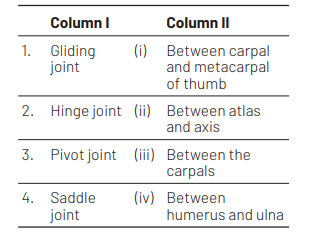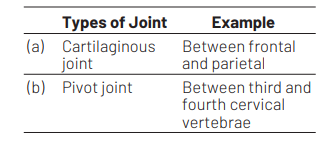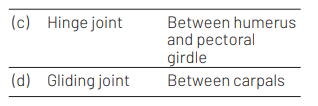Question
Match the following joints with the bones involved [NEET (Odisha) 2019]

Select the correct option from the following
1 2 3 4
(a) (iii) (iv) (ii) (i)
(b) (iv) (i) (ii) (iii)
(c) (iv) (ii) (iii) (i)
(d) (i) (iii) (ii) (iv)
Answer/Explanation
Ans. (a)
The correct matches are
1. Gliding joint-(iii) Between the carpals
2. Hinge joint – (iv) Between humerus and ulna
3. Pivot joint – (ii) Between atlas and axis
4. Saddle joint-(i)Between carpal and metacarpal of thumb
Question
The pivot joint between atlas and axis is a type of [NEET 2017]
(a) fibrous joint
(b) cartilaginous joint
(c) synovial joint
(d) saddle joint
Answer/Explanation
Ans. (c)
The joint between atlas and axis is a type of synovial joint. A considerable movement is allowed at all synovial joints. They are surrounded by tubular articular capsule. The capsule consists of two layers, i.e. outer fibrous capsule and inner synovial membrane, which secretes synovial fluid lubricates and providing nourishment to articular cartilage.
Concept Enhancer Fibrous joint They do not allow movement because the bones are held firmly by bundles of white fibrous tissue. e.g. joint between the bones of skull.
Cartilaginous joints They allow slight movement; because of the elastic pads of fibrocartilage present between the ends of the bones taking part in the joints, e.g. pubic symphysis of pubis.
Saddle joints This is the type of synovial joints. This type of joint is like ball and socket joint, but not developed fully, e.g. joint between carpal of hand.
Question
Which of the following joints would allow no movement? [CBSE AIPMT 2015]
(a) Fibrous joint
(b) Cartilaginous joint
(c) Synovial joint
(d) Ball and socket joint
Answer/Explanation
Ans. (a)
Fibrous joints are immovable joints that occur between the bones of the cranium and in the tooth sockets. They do not allow movement because the bones are held firmly together by bundles of strong white collagen fibres. The immovable joints are often known as the sutures. The periosteum that covers the bones dips between them as a septum.
Question
Select the correct matching of the type of the joint with the example in human skeletal system[CBSE AIPMT 2014]


Answer/Explanation
Ans. (d)
Gliding joint is a type of synovial joint, found between carpal bones and tarsal bones. Cartilaginous joint between surfaces of skull bones. Pivot joint is found between the atlas and axis. Hinge joint is found in elbow, knee ankle and interphalangeal joints.
Question
The characteristics and an example of a synovial joint in humans is [NEET 2013]

Answer/Explanation
Ans. (c)
Joint between atlas and axis is pivot joint, which is an example of synovial joint characterised by the presence of a fluid-filled synovial cavity between the articulating surface of the two bones. Knee joint (hinge joint) is a synovial joint characterised by the presence of fluid filled synovial cavity between the articulating surfaces of the two bones. Fluid cartilage between two bones having limited movements is slightly movable joint.
In freely movable joints fluid filled between two joints provides cushion. In gliding joint, the articulating bones can slide upon one another.
Question
Elbow joint is an example of [CBSE AIPMT 2009]
(a) pivot joint
(b) hinge joint
(c) gliding joint
(d) ball and socket joint
Answer/Explanation
Ans. (b)
In hinge joint, the convex surface of one bone fits into the concave surface of another bone, e.g. knee, elbow and interphalangeal joints. Pivot joint, one bone is fixed and second articulated, e.g. atlas and axial of shull rotate with axis vertebra. Gliding joints primarily permit side-by-side and back-and-forth gliding movements, e.g. intercarpal joints and intertarsal joints.In ball and socket joint, ball of one bone articulates in socket of another bone, e.g. head of humerus and glenaid cavity of pectoral girdle.
Question
Which of the following pairs, is correctly matched? [CBSE AIPMT 2005]
(a) Hingejoint – Between vertebrae
(b) Blidingjoint – Between zygapophyses of the successive vertebrae
(c) Cartilaginous – Stull bones joint
(d) Fibrous joint – Between phalanges
Answer/Explanation
Ans. (b)
Gliding joint is present between zygapophyses of the successive vertebrae. This joint permits sliding movements of two bones over each other.
Question
The joint found between sternum and the ribs in humans is [CBSE AIPMT 2000]
(a) angularjoint
(b) fibrous joint
(c) cartilaginous joint.
(d) gliding joint
Answer/Explanation
Ans. (c)
Cartllaginous joints are found between the centra of vertebrae; at pubic symphysis and between ribs and sternum. Fibrous joints are also called as sutures or immovable joints because in these joints the adjoining bones cannot move upon each other, e.g. coranal suture between frontal and parietal bones of skull. In gliding joints, two bones can slide upon each other, e.g. joints between carpals in wrist. In angular joints one bone is movable on another bone in two planes side to side and back and forth, e.g. wrist joints.
